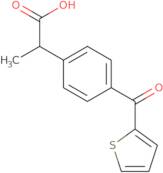Suprofen
CAS: 40828-46-4
Ref. 3D-FS27978
| 10mg | Descatalogado | ||
| 25mg | Descatalogado | ||
| 50mg | Descatalogado | ||
| 100mg | Descatalogado | ||
| 250mg | Descatalogado |
Información del producto
- a-Methyl-4-(2-thienylcarbonyl)benzeneacetic acidp-(2-Thenoyl)hydratropic acidSutoprofen
- (.+-.)-Suprofen
- 2-[4-(Thiophene-2-carbonyl)phenyl]propanoic acid
- Masterfen
- Nsc 303611
- Profenal
- Profenol
- R 25061
- Racemic suprofen
- Srendam
- Ver más sinónimos
- Sulproltin
- Supranol
- Suprocil
- Suprofene
- Suprol
- Sutoprofen
- Tn 762
- Topalgic
- p-(2-Thenoyl)hydratropic acid
- α-Methyl-4-(2-thienylcarbonyl)benzeneacetic acid
- (+-)-2-(p-(2-Thenoyl)phenyl)propionic acid
- Hydratropic acid, p-(2-thenoyl)-
- Maldocil
- para-(2-Thenoyl) hydratropic acid
- Dolasteron
- 2-[4-(thiophen-2-ylcarbonyl)phenyl]propanoic acid
- UNII-988GU2F9PE
- Benzeneacetic acid, α-methyl-4-(2-thienylcarbonyl)-
- p-2-Thenoylhydratropic acid
- 4-(2-Thenoyl)hydratropsaeure
- Suprofenum
- alpha-Methyl-4-(2-thienylcarbonyl)benzeneacetic acid
- Suprofene [INN-French]
- Benzeneacetic acid, alpha-methyl-4-(2-thienylcarbonyl)-
- 2-(4-(2-Thenoyl)phenyl)propionsaeure
- Suprofenum [INN-Latin]
Suprofen is an experimental drug that belongs to the class of nonsteroidal anti-inflammatory drugs (NSAIDs). It inhibits the production of prostaglandin, which is involved in inflammation. Suprofen has been shown to have a protective effect against autoimmune diseases and has been used as a model system for studying the effects of NSAIDs on cells. The chemical stability and biological properties of Suprofen have been investigated using in vitro assays and animal models. However, there are no toxicity studies available for this drug. The reaction mechanism of Suprofen requires intramolecular hydrogen transfer from the sulfonamide group to the phenolic hydroxyl group.





